As you get more involved in cricket as a casual fan or as a player, you’ll begin to realise that there are tons of different deliveries that bowlers can bowl. Some of those deliveries are more visually impressive than others, and some of them are generally more effective at taking wickets. Some of them are a lot more complicated to learn how to bowl, while some are a lot simpler and you can pretty much start bowling them straight away! Basically, there’s a lot of different options available to bowlers – and I wrote about every single one of them in my post linked here!
In my experience, bowlers want to be learning how to bowl the most dangerous deliveries possible, and batters want to know which kinds of deliveries they should be looking out for and learning how to deal with! But what are the most dangerous deliveries? That’s what we’ll be discussing today! If you’re interested in learning how to bowl the most dangerous balls and defend against them too, then this post will be perfect for you.
So, what is the most dangerous cricket delivery?
The most dangerous cricket delivery in terms of dismissing batters is generally said to be the outswinger on a good line and length. However, the inswinging yorker is also a dangerous delivery in most formats of cricket. The most dangerous cricket delivery in terms of the harm it can cause to batters is the beamer.
Of course, there is no 100% correct answer when it comes to defining what the most dangerous cricket delivery is. Everyone will have a slightly different opinion, and what you have read above is a good summary of mine! However, in case you want to hear my reasoning for the above opinion, feel free to keep reading below…
What Is An Outswing Delivery & Why Is It So Dangerous?
‘Swing’ is the name we give to what happens when the ball moves laterally in the air as it is bowled towards the batter (click here if you’d like to read about it in more detail). When the ball is swinging, it looks like it is ‘curving’ through the air. An outswing delivery moves steadily away from the batter as it travels through the air, and this is shown in the diagram below!
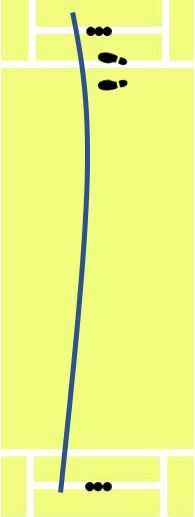
The outswinging delivery is so dangerous for two main reasons. The first reason is simple; the ball is swinging laterally. When the ball is moving sideways in the air like this, the batter cannot be 100% sure how much the ball will swing. Therefore, they have no way of knowing what line the ball will end up on when it reaches them. This means that they could easily end up misjudging the line and getting an outside edge on the ball through to the keeper or the slips.
The second reason is because the ball is swinging away from the bat. This means that in order for the batter to strike the ball, they have to chase the movement as it goes away from them. Playing at the ball while it is a long way from your body can again lead to a lot more outside edges and dismissals!
If the outswinging ball is landed on a good line and length, this makes it even more dangerous for batters. If the bowler can get the ball on the line of off stump, this means that the batter can’t leave the ball alone and that they have to play a shot at the ball, which is exactly what the bowler will be hoping for. Landing the ball on a good length (click here if you want to learn what that is), means that the ball will be just above the height of the batter’s knee once it reaches them, therefore it’s incredibly difficult for the batter to know whether to play on the front foot or the back foot. This type of indecision is great for bowlers! Additionally, the ball lands close enough to the batter so that they won’t have time to react to any movement off the pitch, but also far away enough that if the ball does move off the pitch, it will have deviated significantly from its original path by the time it reaches the bat.
If you want proof that the outswinging delivery is one of the most dangerous in cricket, then you only have to pay attention to what the vast majority of new ball bowlers in cricket try to do with the ball. When you watch the opening overs of a test match innings, you’ll see guys like Jimmy Anderson, Mo Shami, Tim Southee & Trent Boult all trying to get the ball to swing away from the bat. This is because they know this is often their best way of getting a wicket! The same approach is taken for the first couple of overs in 50-overs and T20’s while the ball is swinging. In my opinion it’s something that all new ball bowlers should do their best to achieve.
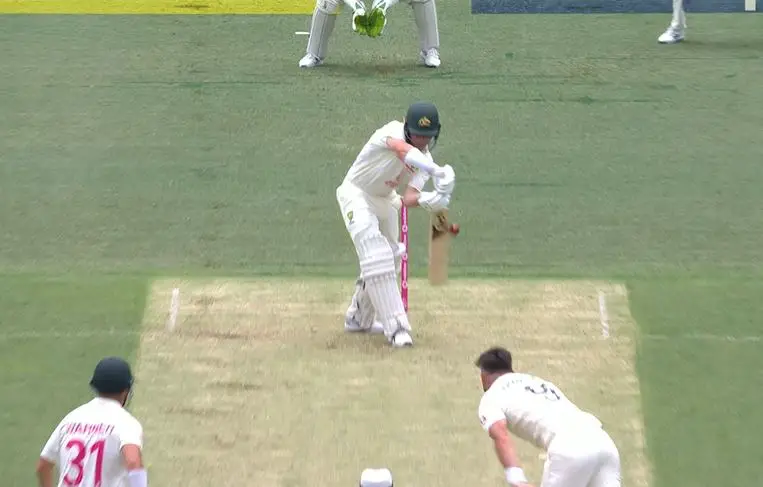
How To Bowl An Outswing Delivery On A Good Line & Length
To bowl an outswing delivery, the main things you’ll need to get right are your grip and the way you release the ball. The steps below should give you a good insight on how to bowl the delivery:
- Hold the ball in the grip required for outswing. The seam of the ball should be angled towards the region where 1st slip would stand, and the fingers should run slightly across the seam rather than parallel with it. This is shown in the photo below! An older cricket ball will always swing in the direction of the most scuffed up side of the ball. So, if you want the ball to swing ‘out’ from left to right, place the scuffed up side of the ball on the right as you put it in your hand. If you want the ball to swing ‘out’ from right to left, place the ball the opposite way.
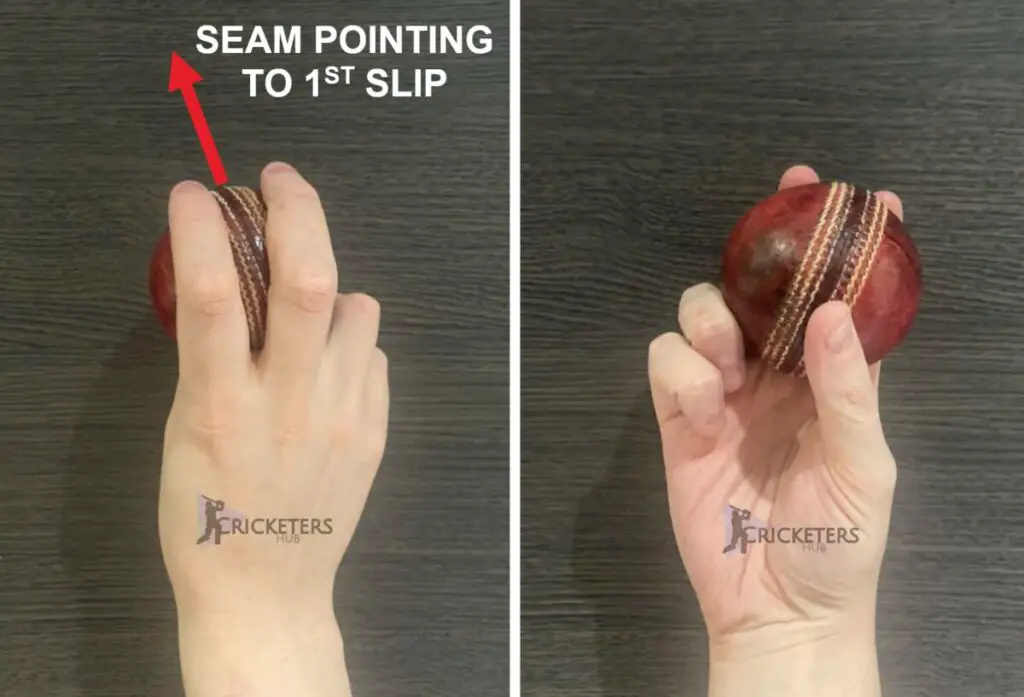
- With the ball in your hand in the correct grip, approach the crease and go through your bowling action exactly as you usually would.
- As your bowling arm rotates and you prepare to release the ball, make sure that the last finger that makes contact with the ball is your index finger. If you can do this, you will be more likely to angle the seam towards first slip as the ball travels through the air, which in turn makes it more likely that the ball will swing in the manner you desire!
You can read a lot more about the technique required to bowl outswing deliveries in my complete outswing guide that is linked here!
If you’re comfortable getting the ball to swing but you want to learn how to bowl the ball accurately on a good line and length, I’d recommend reading my guide on fast bowling accuracy which you can head across to by clicking here!
What Is An Inswinging Yorker & Why Is It Dangerous?
If you’ve read through the previous section on the outswing delivery then you should know what ‘swing’ is. Outswing causes the ball to move away from the batter in the air, but inswing causes the ball to move in towards the batter’s body. As you can probably guess, this makes the inswing delivery an excellent option when it comes to attacking the batter’s pads as well as the stumps!
So, you know what inswing is. But what is a ‘yorker’? Basically, a yorker is a ball that pitches on a very full length. Usually, the ball will bounce somewhere around the feet of the batter or on the line of the popping crease, and you can see this in my diagram below. Yorkers do not land full enough for the batter to hit the ball like they would hit a full toss, and they do not land short enough so that the ball bounces and the batter can hit it on the half volley. The intention when bowling the yorker is to get the ball underneath the bat, hopefully causing it to smash into the stumps.
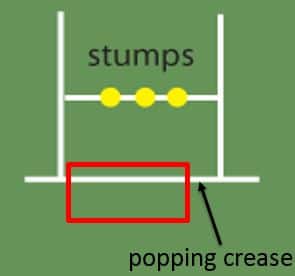
An inswinging yorker is particularly dangerous because when the batter first notices the ball, it will be outside the off stump. When they see this, they may immediately think that the ball isn’t going to threaten their stumps and that they could potentially leave the ball alone or try to strike it through the off side. However, once the ball begins to swing in towards them, it will become clear that they can’t leave the ball alone and that they need to defend instead. If the ball is bowled at high pace, they will not have enough time to slam their bat down defensively and keep the ball out. It could also strike a batter with poor footwork on the foot, leading to an LBW dismissal. In my opinion it’s one of the most satisfying deliveries to bowl and to watch, and can cause batters all kinds of problems.
Not only does the inswinging yorker lead to dismissals like LBW and bowled, but it also makes it very hard for batters to hit boundaries. Because the ball is hitting the ground just as it reaches the batter, it’s very hard for them to get underneath the ball to hit it aerially for 4 or 6. This is why yorkers (and particularly inswinging yorkers if the bowlers can get the ball to move) are so heavily used at the end of T20 and ODI innings, when batters are usually in full attack mode.

How To Bowl An Inswinging Yorker
To bowl an inswinging yorker, you first need to get comfortable swinging the ball in. For some people this comes naturally (just like outswing), but other people may have to adopt some of the tips listed below:
- Hold the ball in the grip required for inswing. For this, you should angle the ball towards where a leg slip would be standing. The ball should be positioned in a way that your fingers are running slightly across the seam, like I’m demonstrating in the picture below. If one side of the ball is more scuffed up than the other, the scuffed up side should be pointing in towards the batter.

- With the ball in your hand in the correct grip, approach the crease and go through your bowling action exactly as you usually would.
- As your bowling arm rotates and you prepare to release the ball, make sure that the last finger that makes contact with the ball is your middle finger. If you can get this release right it will lead to the seam pointing in towards the batter/towards leg slip, which is exactly what you should be hoping for when trying to achieve inswing.
If you feel like you’ve nailed inswing but you want to learn how to bowl yorkers more reliably, you should probably take a look at my complete guide on how to bowl the perfect yorker post which is linked here! That post also contains a number of different accuracy drills that you can use to master this type of ball during your practice sessions!
What Is A Beamer & Why Is It Dangerous?
A beamer is a potentially harmful delivery that passes the batter above waist height, without bouncing on the ground first. Beamers are illegal deliveries that will result in ‘no ball’ being called by the umpire. A ‘full toss’ is another delivery that doesn’t bounce before it reaches the batter, but a full toss is legal because it is below waist height when it reaches them. Beamers are rarely bowled intentionally by bowlers. Instead, they usually occur when the ball accidentally slips out of their hand at the wrong moment.
So, what makes them so dangerous? Well, I’m sure many of you will have already guessed this, but any delivery heading towards the upper body of a batter at high speed has the potential to do some serious damage. Usually, when the ball bounces on the pitch, this takes a lot of the pace out of a delivery. This means that when it reaches the batter the ball won’t be travelling as fast. But because the beamer doesn’t bounce, it doesn’t lose much speed on the journey and gets to the batter incredibly quickly, making it very difficult to react to and avoid. If a beamer strikes the batter anywhere on the upper body, but particularly above the shoulder near the neck or the head, it could cause serious injury.
If you want to see an example of a beamer, click here to watch a video of Mark Wood accidentally bowling one at Travis Head in the Ashes.
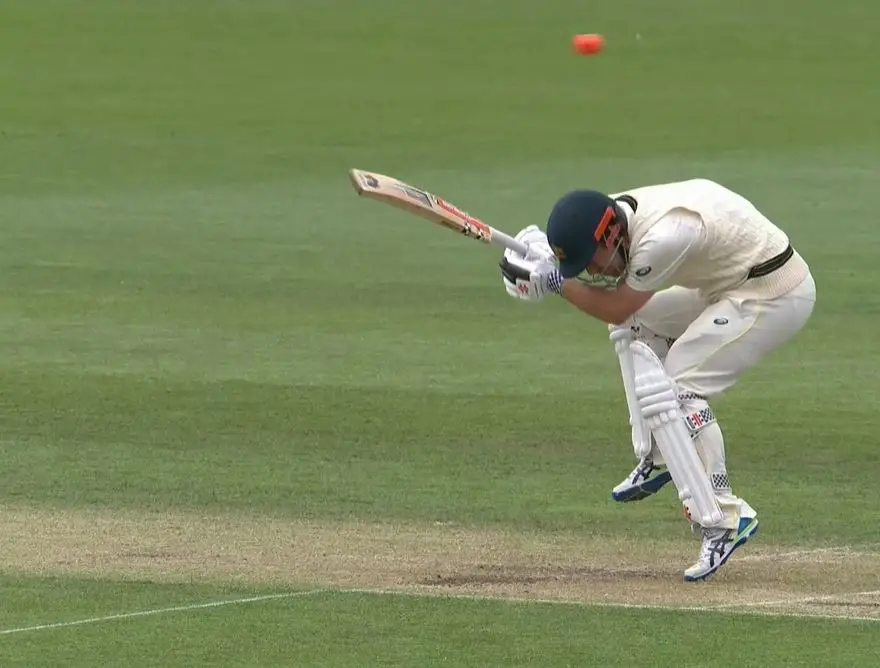
How Should Batters Deal With The Outswinging Delivery On A Good Line & Length?
As we’ve already discussed, the outswinger on a good line and length is one of cricket’s most dangerous deliveries and can easily lead to a dismissal for some of the best batters. So what should batters be doing to combat it? Here are some ideas:
- Watch the ball intently – If you’re going to be able to deal with the swinging ball, you’re going to need to keep your eyes on it in order to gauge the amount of swing.
- Play the ball as late as possible – If you can wait for the ball to reach you and hit it underneath your eyes, rather than prodding the bat out in front of you to meet the ball, you’ll have a much better chance of dealing with the swinging ball. Playing late in this way gives you more chance to read the line, length and movement of the ball
- Try not to chase the ball as it moves – When you’re playing against the swinging ball, you have to accept that some deliveries are going to beat your outside edge and make you look a bit foolish. The main thing is to not chase after the ball when they do! Often, the first instinct batters have when a ball looks like it is going to beat their outside edge is to throw their hands towards the ball and try to make contact with it. This is actually the worst thing you can do and leads to a lot of dismissals! Instead, batters should teach themselves to play the original line of the ball and stick to that.
If you’re wanting to learn how to play the swinging ball better, then I have loads more tips on that in one of my other posts that you can read by clicking here! It also expands much more on the three tips I’ve mentioned above. It’s a great resource for batters who aren’t sure on how to combat this type of bowling and I really think you’ll find it invaluable!
How Should Batters Deal With The Inswinging Yorker?
A perfect inswinging yorker is always a tough ball to face, but there are certain things we can do as batters that will help us to play it a little better. Here are a few of them:
- Watch the ball closely – As I mentioned above, watching the ball carefully is key to playing the ball when it is swinging.
- Don’t plant your front foot too early – Some players like to move their front foot over towards the off side just as the ball leaves the bowler’s hand. This can really get you in trouble against the inswinging yorker! If you move your foot across too far it means that your bat will have to come around your front leg in order to hit the ball. And when the ball is swinging in at high pace, this is very tough to do. Instead, try moving your foot straight down the pitch, or not committing to moving it until you have read the line of the ball. This will set you up better to combat this type of delivery.
- Change your position on the crease – In order to allow themselves to hit yorkers better, elite players like Jos Buttler will move around on the crease to open up new angles for themselves. In particular, a player like Buttler will retreat deeper into his crease than usual in order to try to transform the yorker into a half volley. This allows you to get underneath the ball and hit it with much more power.
If you want more information on these tips, as well as other tactics you can use to combat the inswinging yorker, I’d recommend reading my ultimate guide to batting against the yorker. Click here if that sounds like something you’d fancy having a look through!
How Should Batters Deal With The Beamer?
Now you know how harmful the beamer can be to a batter, I thought that I better give you some pointers on how to deal with it. Sadly, there’s not much you can do apart from stick to the fundamentals of batting!
It’s impossible to prepare yourself for the beamer as it’s such a rare ball to receive and bowlers will probably not be trying to bowl it at you. However, doing the following will ensure that you have the best chance of avoiding being injured by it:
- Keep your eyes on the ball at all times – This tip is an important part of batting no matter what type of delivery you’re facing. If you can keep your eye on the ball as it leaves the bowler’s hand and throughout its journey towards you, you will have a much better chance of taking appropriate evasive action or getting your bat on the ball. A lot of players tend to take their eye off the ball when a beamer is bowled, and this is definitely a natural reaction to being confronted with something you don’t encounter that often, but try to do your best to avoid this.
- Make sure you’re wearing the appropriate protective equipment – It’s critical that batters are wearing all of the proper protective clothing when they’re out in the middle or while they’re training. This is especially important when playing with a real cricket ball and against fast bowling, and it can definitely help you stay protected against deliveries like the beamer. Check my post here to get a full breakdown of all the necessary cricketing equipment!
- Take Evasive Action – If you spot the beamer on its way towards you, your best bet is to do your best to get out of the way of the ball, especially if it’s coming towards you at high pace! Let’s face it, no one wants to take a blow directly on the body from a ball like that! If the ball is coming towards you slowly, then feel free to take a swing at it and try to score some extra runs, but remember, you’ll always be guaranteed one run and an extra ball because the beamer is counted as a no ball.
Conclusion
I hope this post has given you a good insight into some of cricket’s most dangerous deliveries. Two of the deliveries I covered here were great wicket-taking balls, and one was a physically threatening ball that all players would probably rather avoid at all costs.
One legal delivery that I didn’t really cover is the bouncer, which is an amazing weapon for bowlers and can definitely be dangerous for batters to deal with. If you’d like to learn more about the bouncer, I have a guide on how to bowl the perfect one that you can read by clicking here. I’ve also written a comprehensive manual on how to play the short ball that you can check out by clicking this link! I hope you enjoy your stay on the site!
